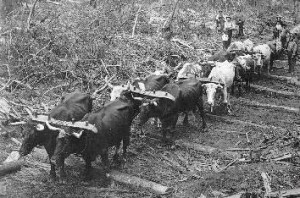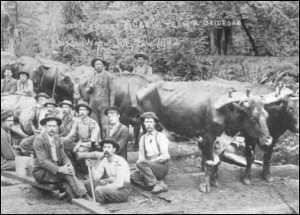If you drive out of Portland headed north towards Scappoose and the Oregon side of the Lower Columbia, you are likely to travel along Yeon Avenue. The pronunciation of this road is usually a foolproof way to tell longtime Portland residents from more recent arrivals. The latter are likely to pronounce this name as if it had no “y” and sounded like a long period of time, an “eon”. But the mildewed old timers will omit the “e” and refer to this industrial thoroughfare as “yon”.
 But few will understand how fitting it is that this broad arterial dedicated to the transportation of heavy industrial goods should honor one of Portland’s most successful bullwhackers. And Jean Baptiste Yeon (1865–1928) certainly was one of the most successful bullwhackers that Portland, and the Pacific Northwest ever saw!
But few will understand how fitting it is that this broad arterial dedicated to the transportation of heavy industrial goods should honor one of Portland’s most successful bullwhackers. And Jean Baptiste Yeon (1865–1928) certainly was one of the most successful bullwhackers that Portland, and the Pacific Northwest ever saw!
When the first loggers arrived in the Northwest they realized that the size of the trees , the rough terrain and the sodden conditions made it impossible to log with horses. They realized that they needed enormous strength and a strong steady pull. Consequently, they quickly traded their horse teams for oxen. For half a century “bulls” as the loggers referred to them, did most of the heavy lifting in the Pacific Northwest. Often they would hitch five, six and even ten yokes of bulls together to pull the massive trunks of Oregon’s millennial giants down “skidroads” to the river’s edge. The skidroads were made from felled tree trunks laid side by side to form a kind of track that would prevent sliding logs from getting hung up on rocks or buried in the mud.
In a memorable passage in The Holy Mackinaw, Stewart Holbrook, a well known chronicler of Pacific Northwest history, recounts the scene:
“First, you heard the loud, clear call of the bullwhacker’s voice echoing down the forest road that was more like a deep green canyon so tall and thick stood the fir; and the clank of chains and the wailing of oxbows as the heavy animals got into the pull and “leaned on her”. And then the powerful line of red and black and spotted white would swing by with measured tread, the teamster, sacred goadstick over his shoulder, walking beside the team, petting and cursing them to high heaven by turns, the huge logs coming along behind with a dignified roll”.
 The Bullwhacker reigned supreme during the bull-team era; he was the rock star of woods crew. Paid three times as much as an axman, he was the unquestioned authority figure handing down judgement on everything from women to the mysteries of the universe. The bullwhacker presided over the skidroad with a firm and practiced hand, but his explosive profanity could lash any man and beast into unearthly exertion. When profane persuasion failed to arouse the necessary force, his “goad stick”, a slim piece of wood some five feet long with a steel brad in one end, served as the final encouragement. When neither goad stick nor profanity roused his brutish charges to their utmost, a bullwhacker was known to leap upon a bullocks’ back stomping down the entire length of the team, piercing their hides with his calked boots and “yelling like all the devils in hell”.
The Bullwhacker reigned supreme during the bull-team era; he was the rock star of woods crew. Paid three times as much as an axman, he was the unquestioned authority figure handing down judgement on everything from women to the mysteries of the universe. The bullwhacker presided over the skidroad with a firm and practiced hand, but his explosive profanity could lash any man and beast into unearthly exertion. When profane persuasion failed to arouse the necessary force, his “goad stick”, a slim piece of wood some five feet long with a steel brad in one end, served as the final encouragement. When neither goad stick nor profanity roused his brutish charges to their utmost, a bullwhacker was known to leap upon a bullocks’ back stomping down the entire length of the team, piercing their hides with his calked boots and “yelling like all the devils in hell”.
Such a man was “Johnnie” Yeon. Arriving penniless from Quebec, he borrowed enough money to purchase land and a team of bulls and proceeded to cut his way into the hills above Cathlamet. In winter he kept warm bunking alongside his bulls in their so-called “hovel”. He was up at four to feed his huge companions. He worked as a bullwhacker, an ax-man, a cook, a timekeeper and a foreman. He was known to fell a two hundred foot fir tree just for the exercise. He liked to keep in shape, and after twenty years he became one of Portland’s most successful timber barons. In 1911 he built Portland’s first “high-rise” building. The Yeon building was 15 stories high and was clad in glazed terra-cotta, and culminating in a colonnade on the top floors. At the time it was Portland’s tallest building.
While other buildings have long since surpassed Jean Baptiste’s creation, the north-bound road that bears his name still carries loads worthy of his ox-teams! Like his charges, Johnnie was a giant of a man that helped carve this state out of the primeval forests. These days his story is seldom heard, but once known is seldom forgotten.

Hi Jim
I’ve been searching for images of bullwhackers and freighting to use in a documentary film and saw 2 intriguing photos in your blog post of Jan 23, 2012, When Bullwhackers reigned supreme.
Can you tell me where you found them or are they from your personal collection?
Best, Blanche
These pictures probably came from the web site for Columbia County, or the Washington County Historical Society. I have masses of pictures but very little documentation about their provenance.
Thanks for responding Jim!